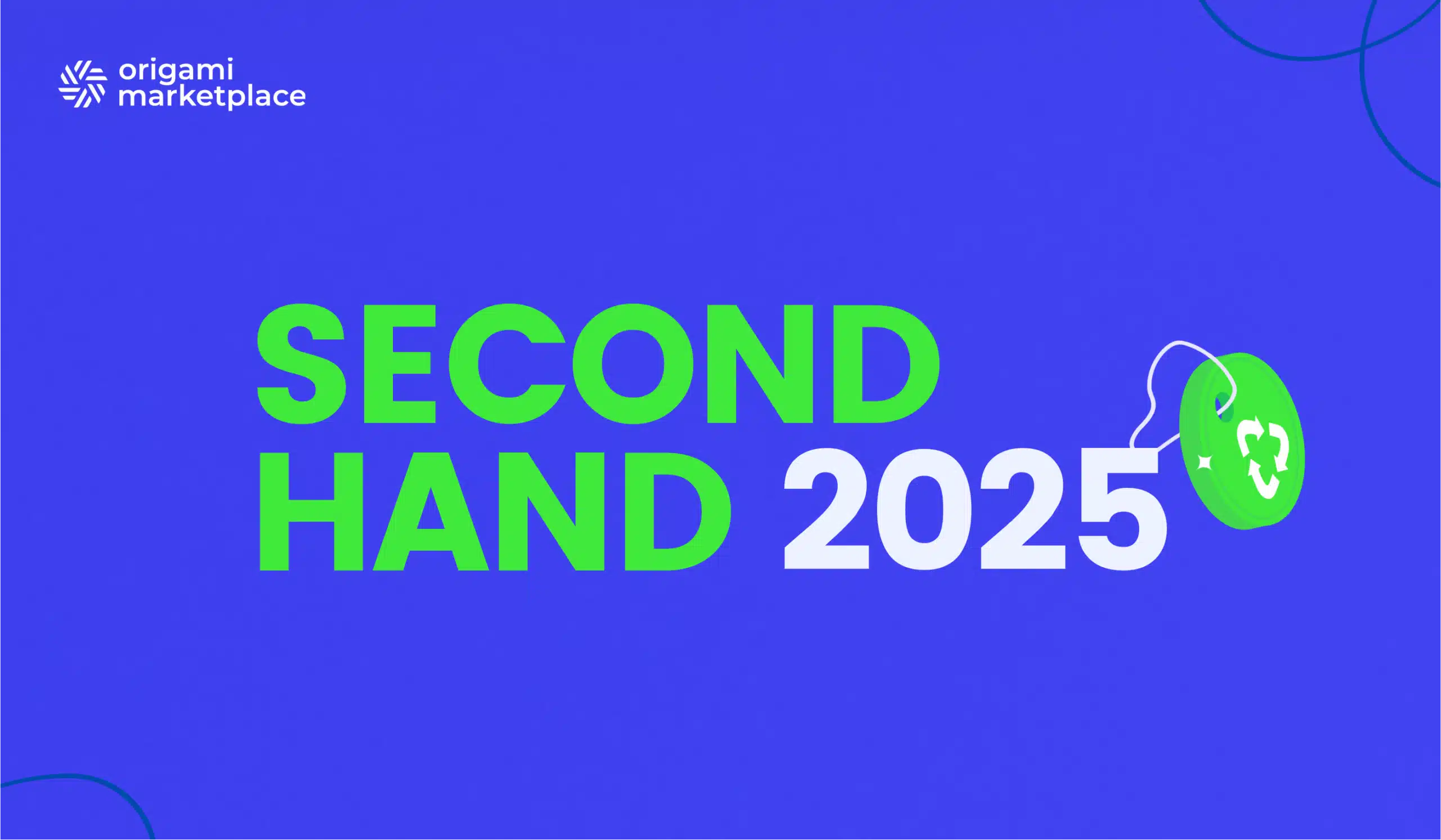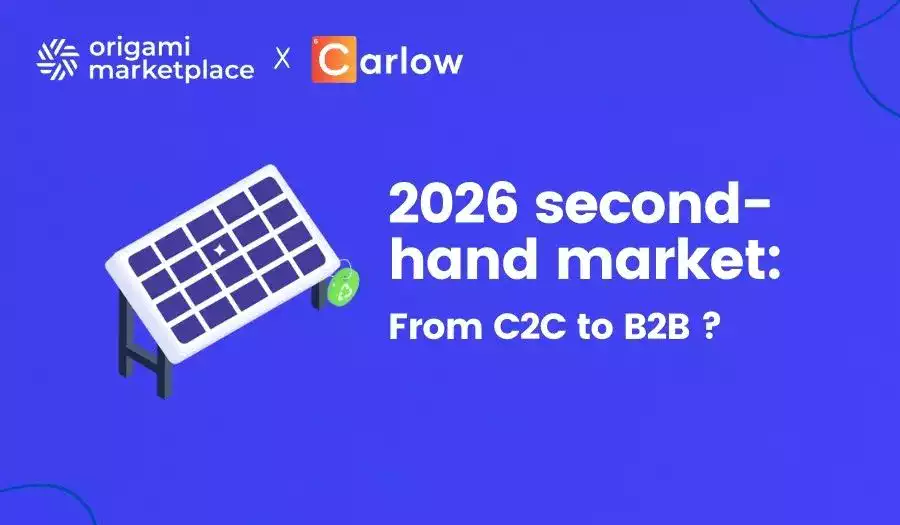The second-hand market in 2025
- Emeline Kerloch
- 6 minutes reading

The second-hand market is undergoing a spectacular transformation, establishing itself as a pillar of the global economy. This boom reflects a major shift in our consumption patterns, driven by a collective awareness of sustainability and environmental responsibility, and exacerbated by falling household incomes. By 2024, the market will move beyond traditional thrift stores and second-hand shops to innovative digital platforms. You may be wondering just how big this sector has become. The numbers speak for themselves: with annual growth of over 15%, the global second-hand market is estimated to be worth $77 billion in 2025. Impressive, isn’t it?
Key points for understanding this new circular market:
1. A fast growing market.
In 2024, the second-hand market will continue to grow at an impressive rate. Worldwide, this market is now worth more than 128 billion euros, with an annual growth rate of 22.00%. This momentum is fueled by several key factors, including a decline in purchasing power, post-pandemic inflation, and a growing awareness of environmental issues. As a result, 46% of consumers surveyed in the Global Consumer Survey said they had bought at least one used product in the past 12 months. In Europe, more than 87% of consumers say they are attracted to the market and 1 in 5 people have sold their phone on the secondary market.
The rapid digitization of the sector and the move towards more responsible consumption practices are paving the way for even more significant expansion in 2025. By 2027, resale is forecast to grow 9 times faster than the apparel retail sector. Circular economy initiatives and consumer commitment to a more sustainable future continue to strengthen the sector. Brands and platforms that integrate sustainability into their business models are particularly well positioned to capitalize on this growth.
Download our free marketplace specifications template.
Here you will find all the essential features to succeed in your C2C, B2C or B2B multi-vendor marketplace. This model provides a simple backlog to guide you through each step of your project.
2. Changing consumer behavior.
In 2023, consumer motivations and preferences in the second-hand market are clear. First and foremost, financial savings are still the main concern, but now a strong environmental awareness and the desire to find unique, high-quality products are also part of the equation. Do you see yourself in this trend? Consumers are choosing second-hand goods to reduce their expenses and contribute to a sustainable lifestyle.
Younger generations are particularly sensitive to these issues and are looking for alternatives. About 70% of Millennials and Generation Z say they are willing to buy used products to minimize their environmental impact. This trend is coupled with a global awareness of the challenges of global warming and over-consumption.
The search for uniqueness and quality is also key. Consumers increasingly value items with a story behind them, looking for vintage pieces or branded items at affordable prices. Platforms such as Vinted and Depop are becoming playgrounds for finding these treasures, offering a wide selection of high-quality, original products.
There is also a clear generational divide. Older generations value used goods for their affordability, while younger generations are motivated by environmental concerns and the desire to stand out with unique choices. Understanding these nuances is essential to meeting the diverse needs of each consumer segment.
3. Second-hand at the center of brand strategies.
Team tips 🎓
The second-hand market has experienced impressive growth and has established itself as a vital part of the global economy. Here are our team’s top tips for making the most of this dynamic sector:
- Monitor market growth: The second-hand market is growing rapidly. It reached $64 billion in 2024, with an annual growth rate of 15%. Capitalize on this trend by integrating sustainability strategies into your business model.
- Understand consumer trends: Consumers, especially millennials and Generation Z, are increasingly aware of environmental issues and are looking for unique products. Adapt your offerings to meet these new expectations.
- Incorporate used goods into your strategy: Brands must adapt by adopting circular approaches such as resale or recycling programs. This strengthens their environmental commitment and competitiveness.
- Address challenges and capitalize on opportunities: Increased competition and brand perception management are major challenges. However, by actively engaging in the Second-Hand sector, brands can broaden their customer base and strengthen their brand image.
- Assess environmental and social impact: Second-hand reduces carbon footprints and waste, while democratizing access to quality goods. Support this trend towards a fairer, greener society.
- Consider creating your own platform: Creating a platform for used goods can position you as a leader in this fast-growing sector and diversify your revenue streams.
The Second-Hand Market of 2025 is a unique opportunity for businesses. By being part of this revolution, you’ll be contributing to a more sustainable and responsible future. Are you up to the challenge? Our team of experts is ready to answer your questions.
4. Economic challenges and opportunities in the second-hand market.
5. The environmental and social impact of second-hand goods.
The environmental and social impact of the second-hand market is deeply transformative, reflecting a significant convergence between environmental preservation and social progress.
At the environmental level, reusing and repurposing products directly contributes to reducing carbon footprints and minimizing waste. For example, by choosing used products, consumers play a crucial role in reducing the demand for the production of new goods, which leads to a significant reduction in the use of natural resources and the energy required to manufacture new products.
This practice also helps address the growing problem of landfills, where huge amounts of clothing and other items end up each year. By extending the life of products, it reduces the volume of waste.
On a social level, the second-hand market democratizes access to high-quality goods, allowing people from all economic backgrounds to enjoy products that would otherwise be inaccessible to them.
In addition, the second-hand market fosters entrepreneurship and supports local economies by providing platforms for sellers to generate additional income. In addition, by promoting the values of conscious and responsible consumption, the second-hand market encourages individuals to reflect on their purchasing habits, thus supporting a change in behavior towards more sustainable lifestyles.
Ultimately, the rise of the second-hand market illustrates a beneficial economic model where environmental and social benefits are mutually reinforcing, paving the way for a more equitable and environmentally friendly society.
6. Why build your own second-hand platform?
Creating your own second-hand platform could be the opportunity you’ve been waiting for.
1. Capitalize on a booming market: The second-hand market is experiencing explosive growth. By capitalizing on this trend, you can position yourself as a key player in a dynamic and expanding sector. Imagine being at the heart of this transformation, facilitating access to quality products while promoting responsible consumption practices.
2. Meet consumer expectations: Consumers are looking for economic and sustainable solutions. By launching a second-hand platform, you can meet these needs and attract customers who are concerned about their environmental impact. Wondering how to retain these customers? Offer an exceptional user experience and a diverse, high-quality product selection.
3. Promote the circular economy: By creating a platform dedicated to the resale of products, you are helping to reduce waste and extend the life of items. This ecological approach can not only enhance your brand image, but also attract new customers and partners who share the same values. A great way to stand out from the crowd, don’t you think?
4. Leverage innovative technologies: Today’s technology solutions make it easier to create and manage online marketplaces. Solutions such as Origami Marketplace offer powerful tools to build, customize and manage your own platform efficiently. Why not use these technologies to create a unique and intuitive shopping experience?
5. Generate new revenue streams: A second-hand platform can diversify your revenue streams. In addition to commissions on sales, you can offer premium services, targeted advertising or strategic partnerships. These additional revenues can significantly increase your sales.
6. Innovate and differentiate: In a competitive landscape, innovation is essential. Offering unique features, personalized services, and a seamless user experience can help you stand out from the competition and create loyal customers. Think innovative sorting options, personalized recommendations, or eco-friendly delivery services.
7. Contribute to a sustainable future: By launching your online marketplace for used goods, you are actively promoting a more circular and sustainable economy. This initiative can have a positive impact on the environment and society, while reinforcing your position as a responsible business.
A brief conclusion on the second-hand market in 2025?
In 2025, the second-hand market represents a golden opportunity for businesses and an important step towards more sustainable consumption habits. It plays a central role in the transition to a circular economy, offering economic, environmental and social benefits. As the market continues to grow, it is not only responding to today’s environmental challenges, but also embodying a vision of a more responsible and sustainable future. Are you ready to join this exciting adventure? Why not start thinking about creating your own second-hand platform today? The future awaits you!
👋 Future online marketplace operator!
Discover how the Origami Marketplace API and partner network can transform your business, regardless of size, with its innovative solution based on the marketplace model.



